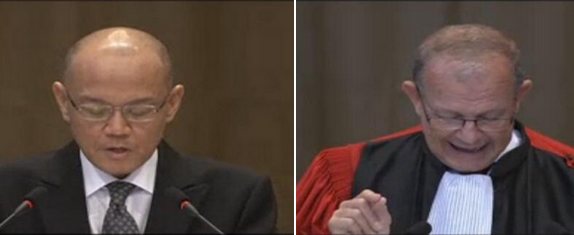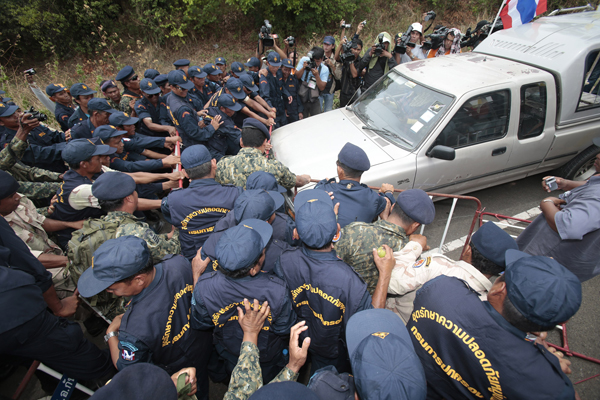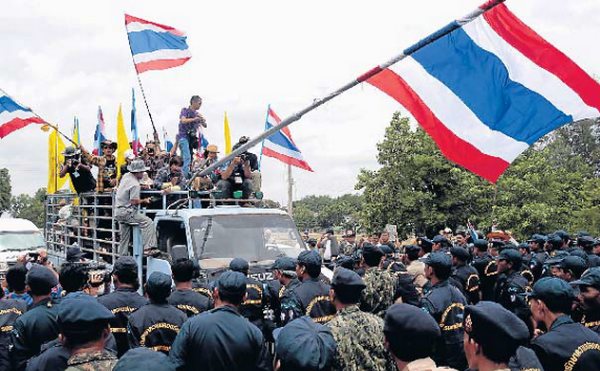Bangkok Post
Cambodia was hoping that the International
Court of Justice (ICJ) would change its 1962 verdict on the Preah Vihear
case when it petitioned the court to reinterpret the ruling, a member
of Thailand's legal team said in an oral statement to the ICJ on
Wednesday.
 Ambassador Virachai Plasai and Thai government counsel Professor
Alain Pellet were among those who addressed the International Court of
Justice on behalf of Thailand Wednesday.
Ambassador Virachai Plasai and Thai government counsel Professor
Alain Pellet were among those who addressed the International Court of
Justice on behalf of Thailand Wednesday.
Donald McRae said Phnom Penh had asked the ICJ to reinterpret the
1962 verdict, which awarded the possession of the ancient Preah Vihear
temple to Cambodia, because it wanted the court to rule that the
boundary line is defined by a French-made 1:200,000-scale map. [This map, called Annex 1 Map, was used by the ICJ in 1962 to reach its decision].
However, the court declined to rule on the map in 1962, and said specifically it had no jurisdiction to decide on demarcation.
Phnom Penh's petition lacked clarity and specificity, McRae said.
Virachai Plasai, Thai ambassador to the Hague and leader of the legal
team, said his Cambodian counterparts had fabricated information and
attempted to mislead the court by using a falsified map to back its
request for an interpretation of the court's 1962 ruling on the temple. [This map was not a falsified map. It was drawn by the Franco-Siamese Mixed Commission in 1908 and was accepted by the then Siamese government. The ICJ used the map to reach its decision in 1962. On the contrary, the map used by the Thai team was unilaterally drawn by Thailand and therefore it is tantamount to falsifying the map by Thailand].
Mr
Virachai told the court Cambodia showed the fake map during its
presentation of its statement on the case earlier this week with the
intention of creating a misunderstanding. The map was different to the
one attached in its petition to the court. [Thailand showed the fake maps because all the maps presented by the Thai side are unilaterally drawn by Thailand without the agreement of Cambodia and therefore have no legal base under international treaties and international laws].
The map clearly showed the Preah Vihear temple was situated on the
Cambodian side but the border lines shown in the two maps were
different, Mr Virachai said.
 A "patriot" group held a rally in Si Sa Ket on Wednesday aiming to
raise the Thai national flag on the 4.6-square-kilometre patch of land
around Preah Vihear.(Photo by Pattarachai Preechapanich)
A "patriot" group held a rally in Si Sa Ket on Wednesday aiming to
raise the Thai national flag on the 4.6-square-kilometre patch of land
around Preah Vihear.(Photo by Pattarachai Preechapanich)
"Thailand has strictly followed the 1962 verdict," he said. "But
Cambodia's intention is clear, (and it is) trying to get the court to
interpret the 1:200,000-scale map and trying to get Preah Vihear listed
as a World Heritage Site," Mr Virachai said.
Alina Miron, an attorney representing Thailand, said the
1:200,000-scale map drawn by France that was proposed to the judges by
the Cambodian side, had many versions and they have to be considered
thoroughly.
She said many map experts agreed that the map could not be used as a reference because it has geographical errors.
Many inaccuracies can be found when the French-made map is placed on top of the current map, Miron said. [Because the current map was drawn by Thailand alone without Cambodia's agreement and therefore has no legal validity under international laws, while the French-made map was drawn by the Franco-Siamese Mixed Commission with the Thai agreement].
Alain Pellet, another lawyer representing Thailand, said the barbed
wire laid around Preah Vihear by Thailand 51 years ago was to set the
boundary line of the ancient temple, not to demarcate the Thai-Cambodian
border.
Pellet said the late King Norodom Sihanouk appeared happy and
celebrated at Preah Vihear after learning that Thailand had laid barbed
wire around the temple a week after the verdict was delivered.
Deputy permanent secretary for foreign affairs Nuttavudh Photisaro
phoned in from the Netherlands to the Foreign Ministry on Wednesday,
saying he believed that Thailand's oral statement to the International
Court of Justice (ICJ) would be able to convince the judges to rule in
Thailand's favour.
Prime Minister Yingluck Shinawatra said she was pleased with
Wednesday's court interpreters as they had prepared information in
advance, making it easier for people to understand both sides'
statements.
Meanwhile, a self-styled "patriot" group held a rally in Kantaralak
district in Si Sa Ket province on Wednesday aiming to raise the Thai
national flag on the 4.6-square-kilometre patch of land around the
temple.
About 200 policemen were deployed to stop the effort and control the situation.
Samnieng Suphonpop, 45, one of the group's leaders, drove a pickup
truck up to police lines to confront officers, but she was pushed back
without further problems.
The group's core leaders - Pol Cap Preecha Eiamsuphan, Veerapan
Malaiphan and Kittichai Ponphai - negotiated with police to get past
their lines and into the temple region, but police refused, citing
safety reasons. The group agreed to disperse Wednesday afternoon, but as
a final act gave a large Thai flag to the police and the district chief
with a request they plant it in the disputed area.
 More than 100 members of the South Isan Land Protection Network try
to enter the disputed 4.6-square-kilometre area around the Preah Vihear
temple in Kantharalak district of Si Sa Ket to put up a Thai national
flag Wednesday. They were blocked by a combined force of soldiers and
police. (Photo by Pattarapong Chatpattarasill)
More than 100 members of the South Isan Land Protection Network try
to enter the disputed 4.6-square-kilometre area around the Preah Vihear
temple in Kantharalak district of Si Sa Ket to put up a Thai national
flag Wednesday. They were blocked by a combined force of soldiers and
police. (Photo by Pattarapong Chatpattarasill)
1 comment:
Cambodia has agenda? Agenda my foot; a seam invaded Khmer land and you baboons played the the victims!!! Stop acting like 10 years old kids fools baboons and grow up for once. Khmer will not be taking our land back form you baboons so therefore, help Khmer develope and become militarily equall to you and youn. We will be partner in all fields once we are fully developed and our fire power is equal or better than your. We know your cilization is still in it's infantile stage even though you are a step ahead of us at this moment. We promise to cilvilized you once we are completely modernized. We are greatfull to you baboons and the leeches for helping Khmer for the past two centuries or so. We will NEVER the forget the baboons and like I said, once we are modernized we even teach you to speak Khmer and everything else great of Khmer.
Post a Comment